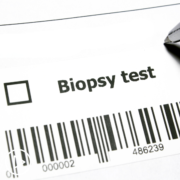How Is AML Care Impacted by Bone Marrow Biopsy Results?
How Is AML Care Impacted by Bone Marrow Biopsy Results? from Patient Empowerment Network on Vimeo.
What is the impact of bone marrow biopsy results on AML care? Expert Dr. Sara Taveras Alam from UTHealth Houston shares how test results are weighed along with patient factors to set a treatment plan and discusses additional patient monitoring, relapse, and how treatment journeys may vary.
Related Resources:

Advancements in AML Treatment | Tailoring Therapies to Individual Patients |

AML Diagnosis | Exploring Bone Marrow Biopsy and Alternatives |

|
Transcript:
Lisa Hatfield:
Dr. Taveras, how does the information gathered from a bone marrow biopsy influence treatment decisions for AML care?
Dr. Sara Taveras Alam:
The information gathered from bone marrow biopsies is crucial to decide on the optimal treatment for our patients. We do take into consideration patient factors such as age, comorbidities, and fitness to decide on the treatment that the patient benefits from; however, they are leukemia specific factors, mainly the driving forces behind that leukemia and mutations that may prompt us to use one treatment or another, so that initial diagnostic bone marrow biopsy is crucial to get the patient started on a treatment course, and then typically, three to four weeks after starting treatment, patients would require what is called a post-induction bone marrow biopsy, so that we can assess the response to treatment, so at that second biopsy, what we’re hoping to see is a patient in a remission, whereas the initial biopsy for an AML patient may have had more than 20 percent blasts or immature cancer cells of AML.
Our goal is that at this end of induction, three to four weeks after starting chemo, the bone marrow shows less than 5 percent blasts, and then we would call that a morphologic remission. In addition, we would be obtaining the chromosome analysis and mutation testing again on those marrows after treatment, because we would love to achieve the highest response possible where we not only eliminate the bad cells, but we are eliminating the driving forces of these bad cells.
So in an ideal situation where our induction treatment does lead into a remission, AML patients still need to undergo what we call consolidation chemotherapy to maintain a remission. Unfortunately, we know that if we stop treatment, our patients with AML will relapse, and the maintenance treatments depending on the regimen, we may have a stop day at four months or six months, depending on the regimen used, and at different time points during the treatment, a bone marrow biopsy may be repeated.
I think the most crucial time for bone marrow biopsies are at the diagnosis and after induction, if we have achieved our goal to achieve remission, then the bone marrow biopsy may be repeated monthly, depending on the institution that the patient is going to.
However, that part is negotiable depending on the patient’s goals and wishes. If the patient were planned for a stem cell transplant because of the characteristics of their leukemia…if it’s a more aggressive type of acute myeloid leukemia, what we call intermediate or poor risk acute myeloid leukemia, a stem cell transplant is recommended, and before proceeding with a stem cell transplant, we must confirm that the patient continues to be in a remission, so that’s another crucial time point to repeat the bone marrow biopsy in addition to the beginning of induction, so they’re getting a diagnosis and the end of that first induction treatment.
The time points between those two are kind of negotiable, especially in patients that have a lot of trouble with the biopsies, but may be very beneficial to confirm that we are keeping the patient into remission and carry the prognosis of the patient.
Of course, if there’s any concern that there’s a relapse, that would be another reason to repeat a bone marrow biopsy, and while confirmed that there has been a relapse and see what characteristics of the AML has changed, and what treatment would be appropriate at that time frame. Once a patient has been in remission, completed their maintenance treatment potentially received a stem cell transplant if it was appropriate for them, usually patients are surveillance clinic followed up, and a bone marrow biopsy is advisable for their first few years, about every three months to confirm that we’re maintaining a remission and that no further action is needed.










